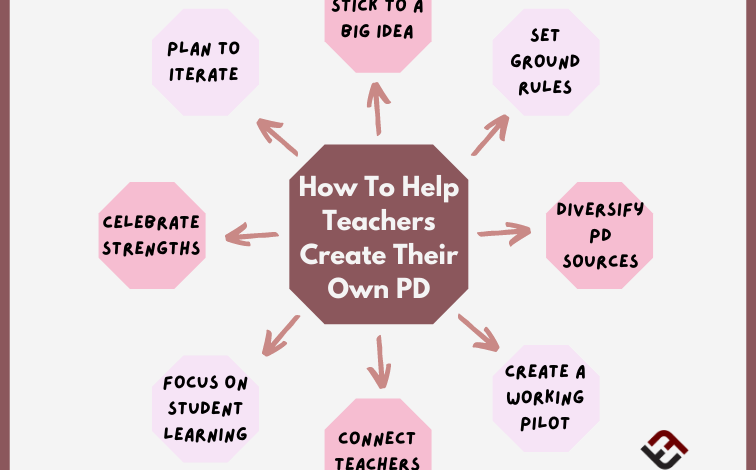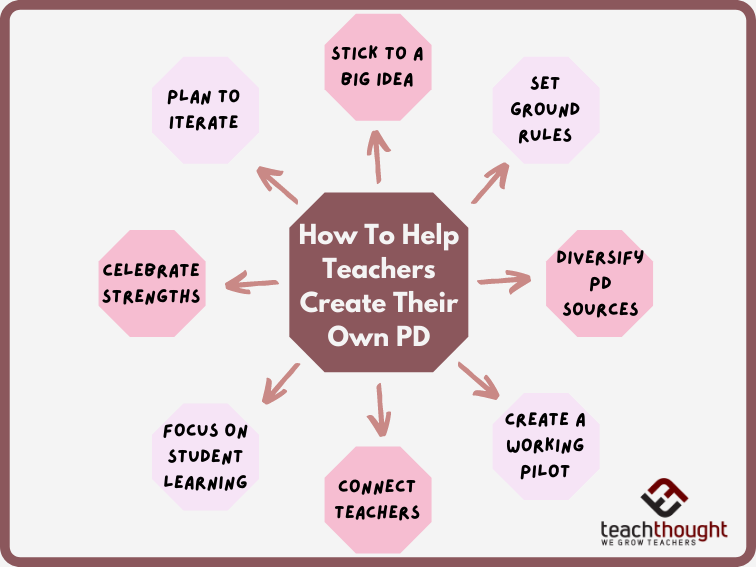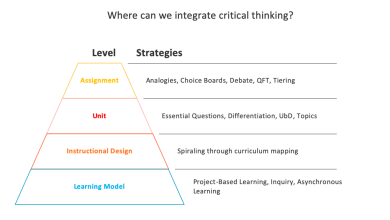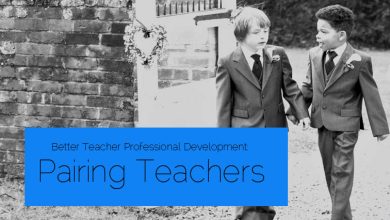8 Steps To Flipped Teacher Professional Development


by Terrell Heick
Traditional teacher professional development depends on external training handed down to teachers after having identified their weaknesses as a professional.
If you’re not so great at teaching writing, or if assessment is becoming a bigger focus in your school or district, you fill out a growth plan of some sort, attend your training, get your certificates, and repeat until you’ve got your hours or your school has run out of money to send you to more training.
Oftentimes, these ‘professional growth plans’ are scribbled out in 15-minute meetings with your principal, then ‘revisited’ at the end of the year as a kind of autopsy. What would happen if we flipped this model on its head? What if, instead, we created a teacher-centered, always-on, and social approach to teacher improvement? One that connected them with dynamic resources and human communities that modeled new thinking and possibility, and that crucially built on their strengths?
The idea here isn’t simply that educators can improve by connecting through social networks- they are already doing that. Rather, that schools can decentralize the teacher training effort by cutting them loose and supporting their self-directed efforts through various resources. The purpose of this post, beyond clarifying how social media-driven and self-directed teacher professional development might work, is to offer some (mostly) concrete ideas for actually getting started designing such a program in your school or district.
Also, note that none of this precludes national-level conferences, on-site PD, and the like. These more central and formal solutions should continue to be powerful PD tools. In fact, a flipped professional development program–one that is self-directed, always-on, and social–could help inform the kinds of conferences and on-site PD most relevant and authentic to your local circumstances.
How To Help Teachers Create Their Own Professional Development
1. Establish a compelling big idea –then stick to it
This can be thought of as a mission or theme, but it’s really more of a tone and purpose. One example could be “To help teachers create always-on development that connects them with networks and builds on their natural strengths and interests.” Then–and this is the critical part–refer back to that constantly as you make decisions that might impact the program. This is your lighthouse.
You can revise this big idea as necessary, but be careful not to drift too far away from it, or you will end up right back where you started: one-size-fits-all, top-down, corporate-driven garbage that almost everyone on your staff despises no matter how much they smile.
2. Set the ground rules
You could probably call this a policy, but it’s the non-policy policy—just some basic rules and a common language to ensure everyone starts and finishes at the same point.
Here you should explain how training will be qualified and quantified–or if it will be qualified or quantified. Also, you’ll emphasize the big idea so it’s crystal-clear—personalizing educator training through self-directed and social media-based professional development. Flexibility and innovation here matter more than uniformity
3. Diversify professional development sources
This is the anti-program program. Less about experts and more about staff capacity. To achieve a self-sustaining, always-on program, the program has to be turned over to the teachers through dozens of sources, from books and district resources to blogging and social media.
And not all teachers will be chomping at the bit to hop on Twitter to beat the bushes—so give them somewhere to start. Maybe a challenge during a staff meeting:
- Find five apps for struggling readers, a book, two articles on better literacy, a short video, and a quick webinar–bonus if you can find a literacy framework to make sense of it all. Then find an elegant way to curate and share it all with the school (our district filter does not block that)
4. Create a pilot or template that works for teachers
Pilot it in one department or grade level at first to work out the bugs, the factors you didn’t consider, and to better understand how it might work yourself. You may find this new open approach to PD confuses folks, and that’s okay. Simply go back to steps one and two.
5. Connect teachers
Connect teachers from different schools or districts—even in different states or countries—to not only improve the diversity of resources but naturally expand professional learning networks in the process. These connections will catalyze the effort as you move on. Relationships and curiosity will take a teacher beyond a policy or minimal requirement.
The point of this whole thing is staff capacity, not corrective training.
See also How We Overcame Challenges To A Flipped Staff Meeting
6. Focus on student learning
When evaluating efforts, offering training, or discussing the process one-on-one, focus on the effects of the content rather than the medium or the source. The idea here hasn’t changed—improved student learning via improved teacher efficacy. The whole point is the ‘stuff’–strategies, tools, and thinking–that ends up in instructional design, curriculum, assessment, classrooms, teacher-student interactions, and ultimately ‘student achievement.’
This, then, should be the program’s focus, not social media or meeting minimum requirements.
7. Celebrate teacher strengths & interests
Teachers need to see themselves as craftspersons–skilled and passionate professionals who are all exceptional somewhere. Strengths could be collaborating with colleagues, assessment design, classroom management, curriculum development, or other traditional educational pillars. But they also might be character-driven artifacts as well–flexibility, creativity, service attitude, and so on.
How? Have them describe one another. Use team-building games that make it okay to brag. Promote reflection and metacognition. Provide a template they can ‘fill in’ that helps them see what they do when they do it, and why. Then, highlight any talents, share them out, and celebrate them.
This maybe should come a bit earlier–or be visible at every step. Traditional PD focuses on correcting weaknesses. Certainly, teachers must continue to train themselves to close gaps in their ability to lead students to learning. But building a program around weakness and deficiency doesn’t do much to rally the troops–and isn’t sustainable in an always-on, self-directed approach.
8. Plan to iterate
Whatever you do the first year will be a trainwreck (compared to the nice and tidy sit-and-get PD). So, from the beginning, everyone should know that it’s all a work in progress—just like the profession itself.
Perhaps the greatest potential here is in the chance to personalize professional development for teachers. The above ideas are too vague to be considered an exact guide, but an ‘exact guide’ really isn’t possible without ending up with something as top-heavy and standardized as the process it seeks to replace–or at least supplement. Instead, focus on the big ideas–personalizing educator training through self-directed and social media-based professional development.
Image attribution flickr user stevegarfield




